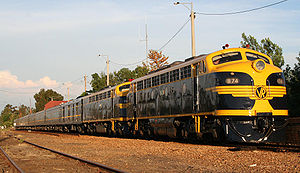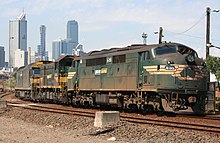Victorian Railways Class B 60
| Victorian Railways Class B 60 | |
|---|---|
|
Class B 60 museum locomotive B 74 in Benalla , behind it a Class S, 2007
|
|
| Numbering: | B 60 to B 85 |
| Number: | 26th |
| Manufacturer: | Clyde Engineering |
| Year of construction (s): | 1952-1953 |
| Axis formula : | Co'Co ' |
| Gauge : | 1600 mm |
| Length over buffers: | 18,542 mm |
| Service mass: | 114 t |
| Top speed: | 133 km / h |
| Hourly output : | 1118 kW |
| Driving wheel diameter: | 1016 mm |
The Class B 60 of the Australian state railway company Victorian Railways (ViCRail) is a series of six-axle diesel-electric locomotives from Clyde Engineering in Granville , New South Wales . The machines were the first diesel locomotives for main lines of the Victorian Railways.
prehistory

Based on the US-American series EMD FP7 , a four-axle diesel locomotive from General Motors Electro-Motive Division (EMD), Clyde Engineering developed a six-axle variant for use in Australia. This was necessary because the axle load could only be limited to around 18 t with two three-axle bogies . In addition, the smaller Australian clearance profile required a lower and narrower car body . This made the machine, which was also better sealed against the ingress of dust, longer than the FP 7.
The 47 standard gauge machines delivered to Commonwealth Railways (CR) from 1951 had the wheel arrangement (A1A) '(A1A)', their bogies (welded construction with Flexicoil coil suspension) were an Australian development. Like their American counterparts, these locomotives of the GM series ( GM-Class ; "single-ended streamliner") had only one driver's cab. 16 or 18 corresponding machines for the gauge 1600 mm (Irish broad gauge) went as Class S to the Victorian Railways and six to the State Rail Authority of New South Wales.
History and description
In 1952/53, Clyde Engineering manufactured 26 locomotives with driver's cabs on both sides for ViCRail on the basis of the GM-Class. The machines built for a track width of 1600 mm had the Co'Co 'wheel arrangement and were called "double-cab units". They are the prototypes of the AA16 built by Nydqvist och Holm (NOHAB) under a GM license and the NMBS / SNCB series 202 by Anglo-Franco-Belge (AFB). As in the FP7 and AA16, the B 60 had water-cooled, slow-running 16-cylinder two-stroke diesel engines of the type GM 567 .
Data of the B 60 in comparison with the FP7 and the AA16
| FP7 (A-Unit) 1 | ViCRail Class B 60 | DSB MY (NOHAB AA16) | |
 |
 |

|
|
| length | 16,662 2 | 17,678 3 | 17,700 3 |
| Width of the car body | 2997 | 2972 | 2920 |
| Height without roof structures 4 | 4267 5 | 4115 | 4150 |
| Wheel alignment | Bo'Bo ' | Co'Co ' | (A1A) '(A1A)' 6 |
| power | 1118 kW | 1118 kW | 1433 kW 7 |
| Top speed | 152 km / h | 133 km / h | 133 km / h |
1 A-Unit: leading power car with a terminal cab and streamlined nose; B-Unit: “Booster” without a driver's cab, which is controlled from an A-Unit
2 via coupling
3 via end beams
4 roof structures: radiator fans, exhaust pipes, signal horns
5 4570 mm incl. Roof structures
6 DSB MY and MX; Co'Co 'for most machines of the Norges Statsbaner (NSB), those of the Hungarian State Railways MÁV and the locomotives
7 DSB MY 1106–1159 and MÁV M61
built by AFB

Victorian Railways initially used the machines in front of express passenger trains and fast freight trains. Over time, they were replaced by more powerful locomotives and pushed into the light passenger train service.
As part of a conversion program, the 1118 kW engine GM 567 B in eleven locomotives was replaced by the 12-cylinder engine GM 645 E3B, which brought it to 1838 kW with a turbocharger . These machines were assigned to Class A, while maintaining the company number 60 ff, and added to the intercity service. These were vehicles 60, 62, 66, 70, 71, 73, 77-79, 81 and 85, which were given the color scheme orange and tangerine. The company, now trading as V / Line, broke off the conversion program in 1987 in favor of purchasing new Class N locomotives.
Whereabouts
Some of the unmodified locomotives came to privatized West Coast Railway . The B 74 has been preserved as an operational museum locomotive.
Remarks
- ↑ 16 according to Rail transport currently 11/1996; 18 according to Continental Modeller 2/2000
Web links
- B class diesel electric locomotives at victorianrailways.net
Individual evidence
- ↑ a b Howard Johnston, Ken Harris: Jane's Train Recognition Guide . HarperCollins Publishers, London 2005, ISBN 0-06-081895-6 , pp. 152 .
- ↑ a b The direct ancestors: Australian Class B 60 in: NOHABs (Eisenbahn Journal special edition 4/2003), p. 15 ff.
- ^ The MY, MV and MX of the Danish State Railways in: NOHABs (Railway Journal Special Edition 4/2003), p. 26.
- ↑ a b c The ancestors: Locomotives of the F series from GM-EMD in: NOHABs (Eisenbahn Journal special edition 4/2003), p. 12 ff.

